What’s changed in GameFi in the last month? — July Report

While the previous bull market saw hundreds of play-to-earn games launched, only a few were able to maintain a steady user base as the market declined. This became apparent in July, when activity continued to fall.
However, the trying market conditions also highlighted the handful of titles that managed to stand out. Splinterlands is one of those projects, retaining users thanks to its low barrier to entry, simple gameplay, and fast battle speed. Axie Infinity also continued to introduce new features to regain momentum.
Footprint Analytics data shows the overall performance of the GameFi sector in July.
- The total number of users decreased by 21% MoM, and the growth of new users was weak.
- Transaction activity was down 55% MoM and 737% YoY.
- The number of projects had a MoM growth of less than 2%.
- VC financing increased by 17% MoM and 126% YoY.
GameFi Market Overall Market Analysis
GameFi project count grew less than 2%, and new project growth in BNB lagged
Less than 80 GameFi projects were launched 3 consecutive months up to July 31. As evident in the chart, all chains saw stagnant growth (although Polygon and WAX are slightly up.)
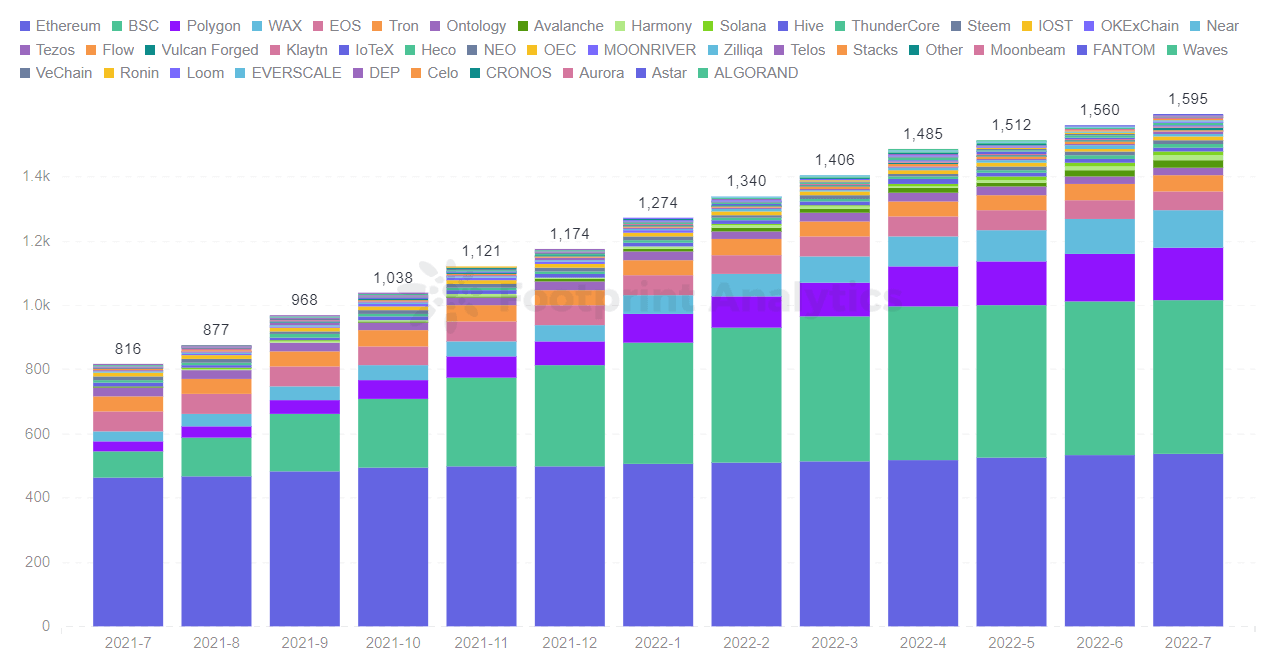
Gamers pay more attention to the playability of the game and the smoothness of the network experience and have extremely high requirements for the network. On the ethereum chain, you need to pay high gas fees at every turn. When encountering the problem of on-chain congestion, it can bring players a very bad experience. Therefore, these issues are a priority for development teams creating new projects.
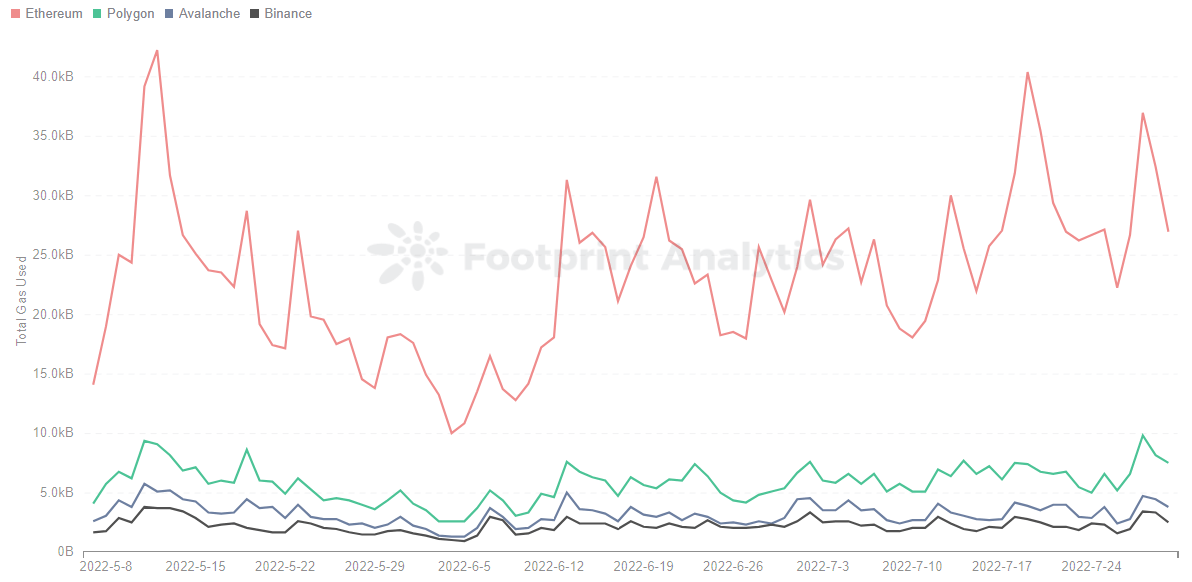
New projects on Ethereum face high fees and congestion, which has led to more projects moving to BSC (now BNB) since July 2021.
This has led BNB to attract a high volume of games that fail to retain users—indicating high quantity, and low quality.


Compared to both chains, Polygon has presented a faster solution with the cost per transaction is about 10,000 times lower than Ethereum, and the transaction speed is up to 7000 tx/s.
GameFi Web3 category accounts for 98% of GameFi’s total funding
With the rise of the Web3 concept in the blockchain, newer scenarios and requirements are introduced into the game industry.
Compared with June, GameFi financing activity gradually recovered in July, increasing by 17%. In terms of funding categories, with the development of blockchain technology, more and more investment funds are injected into Web3-type GameFi, among which Web3-type funding accounts for 98%.
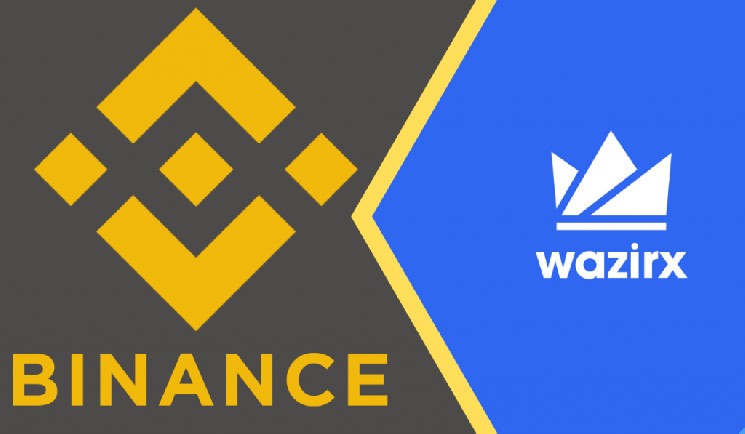
Web3 has entered the public eye since November last year. It wasn’t until after April that Web3 became the focus of the crypto market. And recently, Animoca Brands announced the completion of $75.32 million in financing. It is the second tranche of funding announced following $358.8 million on Jan. 18. With a strong focus on Web3, the company aims to address existing interoperability issues in the metaverse industry to realize its vision of an open metaverse.

A total of 22 projects received financing in July, generally following market fluctuations. Investment rounds are still active at the seed stage for many months, supplemented by other rounds. This is highly related to the active time of users after the project is launched. Judging from the number of active users of the project, the active time of multiple projects such as StarSharks and Cryptomines does not exceed 3 months. Therefore, according to the current project development trend, VC’s investment funds still remain in new projects.


Splinterlands gamers make up the majority of Hive users
Footprint Analytics shows that the total number of monthly users is 1.19 million, of which 483,000 are new users and 710,000 are old users. At the beginning of the year, developers engaged millions of users through a variety of game genres and styles. And they keep trying them out in a wide range of games. Users profit if they can catch a bull market, but if they encounter a bear market, they are in trouble.
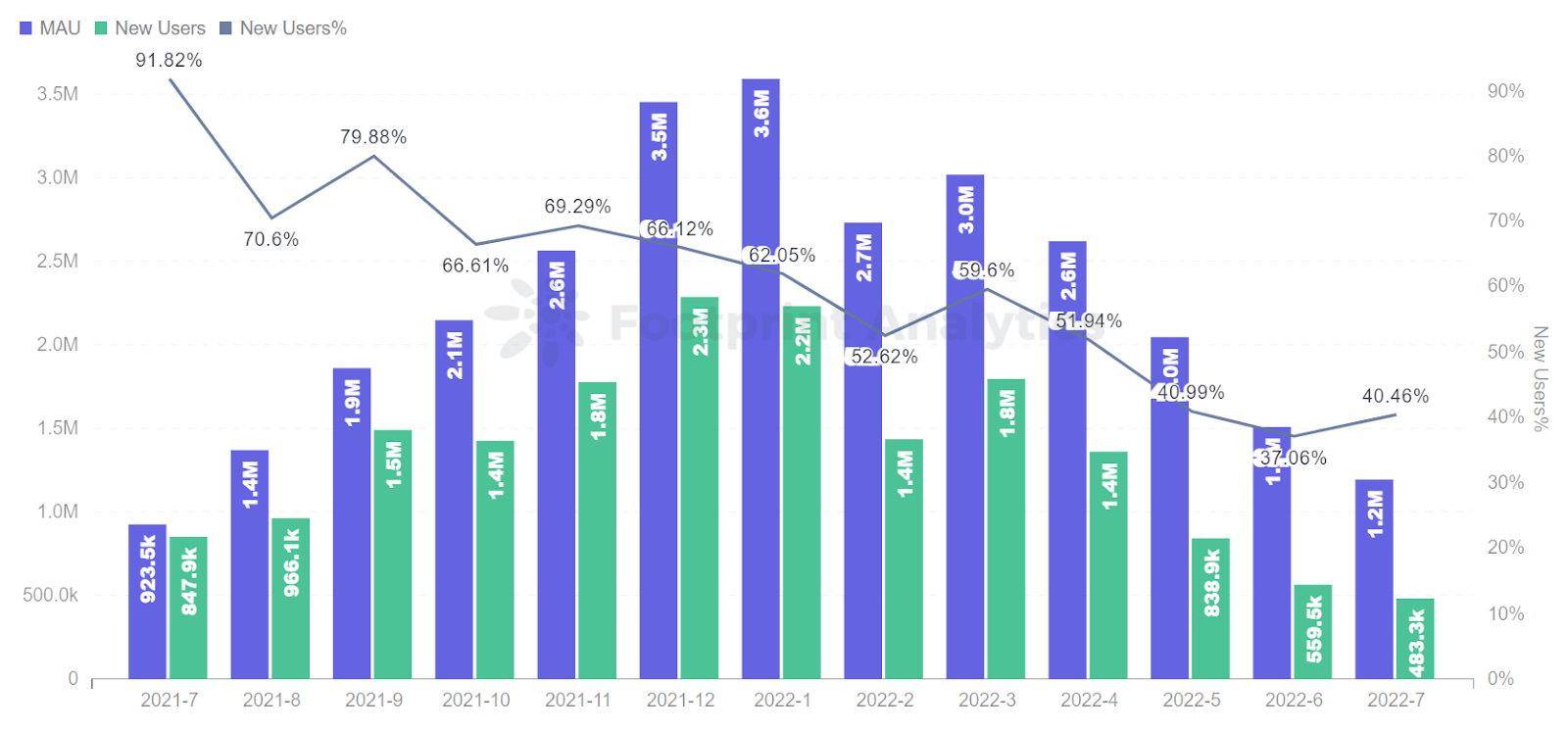
The overall subscriber base has decreased from 3.59 million players in January to 1.19 million in July (-69%). Here are the pain points of GameFi:
- Lack of originality, with an economic model mainly based on mining, output and reproduction.
- Some games require players to invest in game tokens before they can play, and users have a strong demand for capital recovery.
- Infinite inflation model, affected by the bear market, governance token and in-game token prices bring down; their games cannot get rid of the death spiral.
As a result, most P2E games currently require new players to enter to maintain economic stability.
Take Axie Infinity and Splinterlands are two examples.
Splinterlands has been a relatively hot game since its launch. In terms of the percentage of new users in July, Splinterlands is the project with the highest percentage among all the projects.
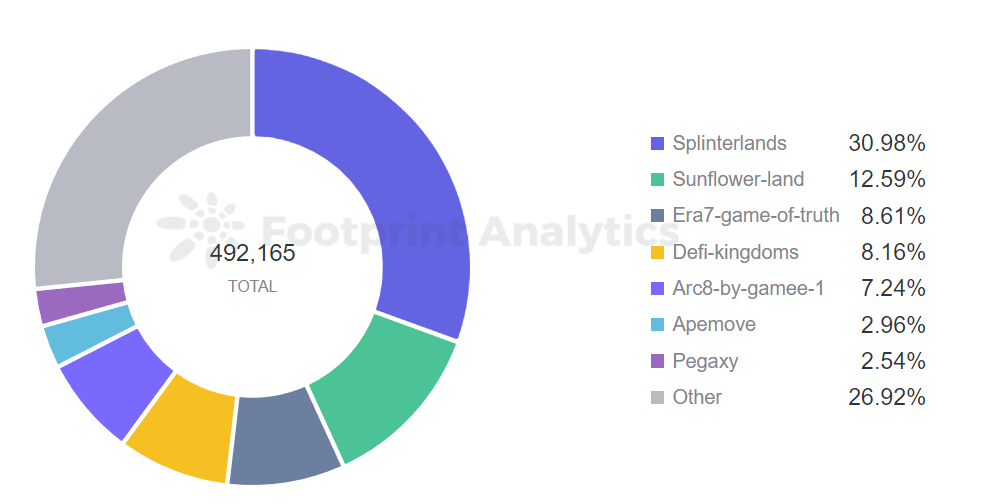
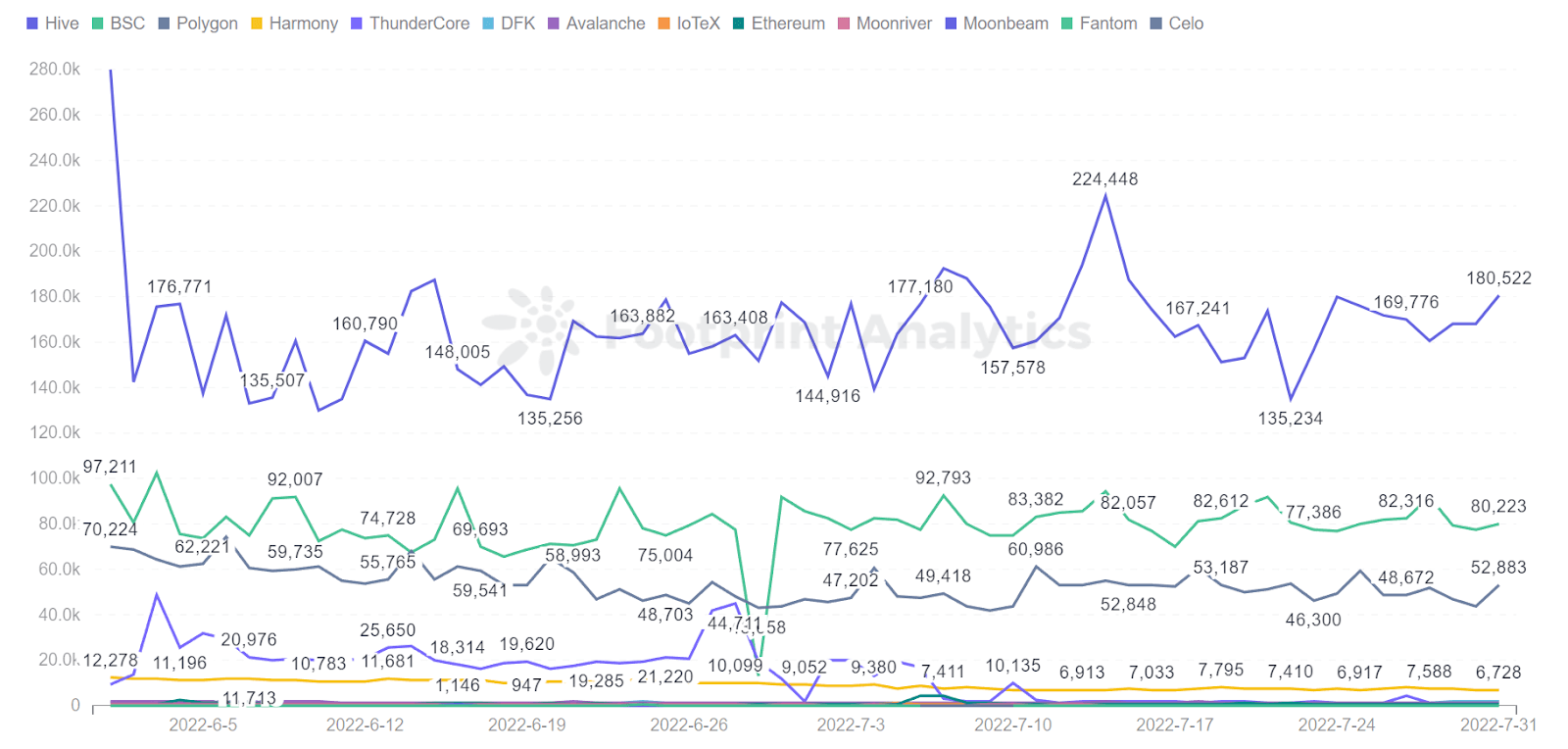
In contrast to Axie infinity before March, to participate in the game to truly gain revenue, real money was required to purchase the pet P2E (expected to be about $110 at the then-currency price). But the cost is high for the average player, and the payback period will lengthen as market trends change. However, Splinterlands requires only $10 to participate in the game, which is a low barrier to entry.
In general, the development team of Axie infinity ignored interesting designs when designing the game and launched the Origin version at the end of March, adding cards and free attributes. And the virtual Land pledge function was launched in early July. I hope users can experience the fun of the game, not just make money.
Axie infinity’s fortunes are turning
From GameFi’s monthly trading volume change, only the period of October-November last year was a period of incremental trading, and after December, the overall trading volume gradually declined until the lowest value in July. This process of change is very similar to the meaning of new projects that appear to attract a large number of players to trade, and then leave after they get tired of playing.

Despite the decline in the GameFi trading market, Ronin was able to buck the trend of declining trading volume on mainstream blockchains and overtake BSC to regain the number one spot. This is mainly due to the launch of the virtual land pledge feature on its on-chain Axie infinity game, which has contributed to the growth of AXS prices and the gradual improvement of the trading volume.
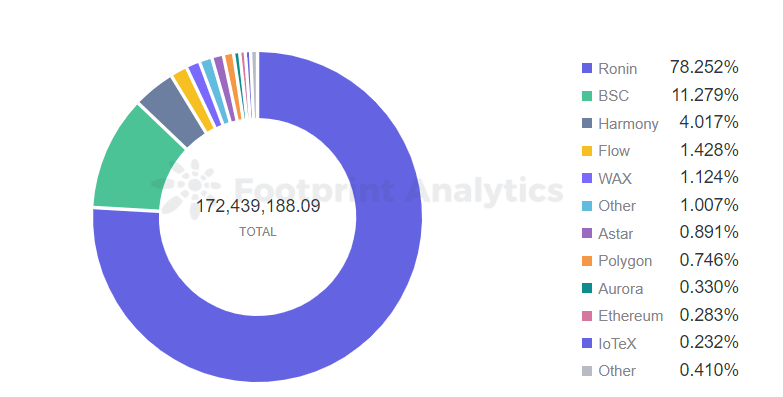
Summary
In the past bull market, many new play-to-earn games were launched, but only a few were able to maintain a steady user base. Splinterlands is one of those projects, retaining users through its low barrier, simple gameplay and fast battle speed. Also, Axie Infinity never stopped innovating, adding new features to regain its status.
At the same time, more funds flowed to Web3 projects in July, aiming to solve more problems for P2E games.
July Events Review
NFT & GameFi
- NFT authentication company optic closes $11M seed round led by Pantera Capital and Kleiner Perkins
- Yuga Labs’ NFT series has generated over $5 billion in total sales and nearly $150 million in royalty revenue
- Video game giant Square Enix plans to drop a final fantasy VII NFT collection in 2023
- STEPN announces Q2 profits & initiates quarterly GMT buyback & burn
- Solana-based MonkeyLeague game developer raises $24 million
Metaverse & Web3
- BAI Capital completed the first fundraising of US$700 million and will focus on Web3, Metaverse and other fields
- Web3 music platform Audius community vault attacked with loss of 18.5M $AUDIO
- Web3 Foundation announced the 14th batch of the funding program; 36 projects were shortlisted
- Magic Eden launches venture unit to invest in web3 gaming startups
- Disney launches startup accelerator program focused on NFTs and the Metaverse
DeFi & Tokens
- Curve to launch an over-collateralized stablecoin
- Decentralized crypto exchange Hashflow raises $25M at $400M valuation
- BTC manages to float above $20K despite recent liquidations and heavy outflows
- Polygon (MATIC) flips this token to become the most traded crypto among ETH whale
- Stablecoin market cap slides, BUSD and DAI valuations jump, Fiat tokens represent 70% of all crypto trades
Network & Infrastructure
- Polygon Launches zkEVM scaling solution for Web3 adoption
- Vitalik Buterin discusses Ethereum’s upcoming “Merge” and “Surge” at EthCC in paris
- Matter labs schedules zkSync 2.0 mainnet launch for October
- Terra-based projects begin exodus to Polygon following Terra collapse
- Solana and Avalanche poised for gains as crypto market enjoys new tailwinds
Institutions
- Three Arrows Liquidators seize $40 Million as asset probe widens
- SEC lists nine crypto tokens as securities following Coinbase insider trading charges
- Tesla dumped 75% of its BTC holdings
- Blockchain.com cuts 25% of its workforce amid a crypto bear market
- Crypto.com integrates Google Pay for users to buy cryptocurrencies
Worldwide
- Reserve Bank of India is working on “Phased Implementation” of Central Bank Digital Currency
- After Terra LUNA Crash S. Korea delays crypto tax
- Ghana ranked as the country with the second-highest debt default risk globally
- Australian regulator trials auto take-down of crypto scam sites
- Bank of Russia says stablecoins are not suitable for settlements
This piece is contributed by the Footprint Analytics community
Aug. 2022, Vincy Data Source: Footprint Analytics – July 2022 GameFi Report



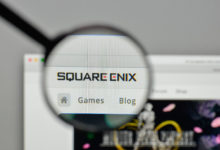


 Bitcoin
Bitcoin  Ethereum
Ethereum  Tether
Tether  USDC
USDC  TRON
TRON  Dogecoin
Dogecoin  Cardano
Cardano  Bitcoin Cash
Bitcoin Cash  Chainlink
Chainlink  LEO Token
LEO Token  Stellar
Stellar  Monero
Monero  Zcash
Zcash  Litecoin
Litecoin  Hedera
Hedera  Dai
Dai  Cronos
Cronos  OKB
OKB  Tether Gold
Tether Gold  Ethereum Classic
Ethereum Classic  KuCoin
KuCoin  Gate
Gate  Algorand
Algorand  Cosmos Hub
Cosmos Hub  VeChain
VeChain  Dash
Dash  Stacks
Stacks  Tezos
Tezos  TrueUSD
TrueUSD  IOTA
IOTA  Basic Attention
Basic Attention  Decred
Decred  Theta Network
Theta Network  NEO
NEO  Synthetix
Synthetix  Qtum
Qtum  Ravencoin
Ravencoin  0x Protocol
0x Protocol  DigiByte
DigiByte  Zilliqa
Zilliqa  Nano
Nano  Holo
Holo  Siacoin
Siacoin  Numeraire
Numeraire  Waves
Waves  Ontology
Ontology  Enjin Coin
Enjin Coin  Status
Status  BUSD
BUSD  Pax Dollar
Pax Dollar  Hive
Hive  Lisk
Lisk  Steem
Steem  Huobi
Huobi  NEM
NEM  OMG Network
OMG Network  Bitcoin Diamond
Bitcoin Diamond  Augur
Augur  Bitcoin Gold
Bitcoin Gold  Ren
Ren